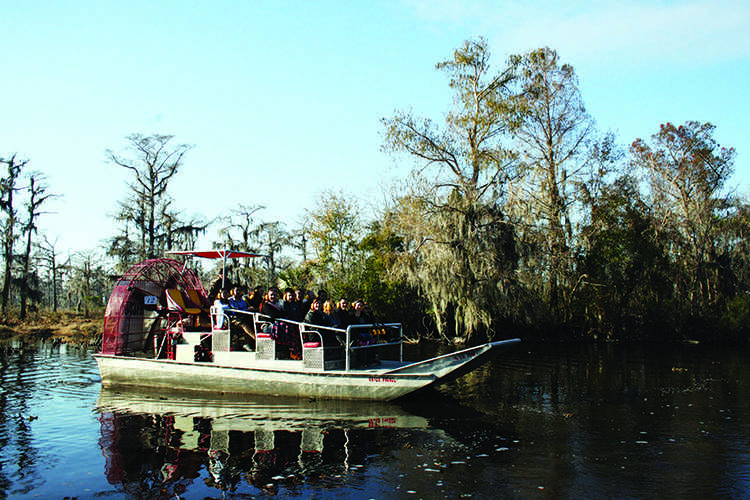Active learning opportunities create more than memories
Getting outside of the classroom is beneficial to academic learning, career preparation
Photo by unknown
Civil Rights Pilgrimage students took a swamp tour outside of New Orleans on Jan. 9 to immerse themselves in the local culture. © 2014 Martha Landry.
January 23, 2014
A group of UW-Eau Claire students recently embarked on the Civil Rights Pilgrimage, which is a high intensity, concentrated 10-day adventure from Atlanta to Selma, Miss., to New Orleans and Memphis, Tenn. The trip follows the civil rights trail, integrating historical accounts with current day social injustice.
But one of my favorite parts of the trip is the opportunity to learn in an out-of-classroom setting — also called active learning. Active learning is characterized by student engagement instead of passive listening. This means as students were able to touch and feel the history of churches of the Civil Rights Movement, walk on the roads where protesters were beaten for standing up for their rights, stand on the cement where the Rev. Martin Luther King, Jr. was assassinated, speak with survivors of Bloody Sunday as well as many other experiences. (For example, eating the amazing chow. Hello, gumbo!).
Both of these classes also have classroom time, either before or after the trip, but what drives home the message is the active education.
Traditional teaching methods are obviously successful, otherwise we wouldn’t still be using them. But experiencing and learning first hand has a much larger impact than reading about it in a book.
Personally, Eau Claire holds a special place in my heart, but one of the main reasons I am so incredibly grateful for the university is the traveling educations that are incredibly different than standard lecture. I have gone on short trips to museums in Eau Claire. I have trekked all across the South with associate professor of journalism Jan Larson where students have interviewed racial integration activists, experts on urban planning and national disasters and even the man who fingerprinted Rosa Parks.
The biology, geography and geology departments take the most field trips out of any discipline, according to the College of Arts and Sciences, but music and theater classes also travel quite a bit. Kathy Lavalley, program assistant for the College of Arts and Sciences, said trips vary from trips to ethnic restaurants to museums in the cities to trips to display data and posters that students have created.
Blugolds have gone to India, France, out West and many other places on educational experiences where they learned culture, life skills and classroom information. I know countless people who have taken advantage of National Student Exchange and studying abroad to all parts of the world. Salsa dancing lessons in Costa Rica may not dramatically improve someone’s Spanish, but it allows them to immerse themselves in a new experience.
Jacqueline Bonneville, assistant dean of students and NSE coordinator, said on average 50 students participate in NSE during each academic year. According to the Center for International Education 2013-2014 annual report, 413 students studied abroad in the previous school year. These programs often have grant and scholarship programs to lighten the financial burden and often have credits that transfer back to Eau Claire.
According to a 2012 International Education of Students survey over more than 1,000 post-study abroad students, 84 percent said studying abroad helped build job skills. Forty-nine percent of students said studying abroad helped develop confidence in his/her first job and 30 percent said it was very effective.
I challenge students to better themselves and push past their comfort zones. Seek out classes that require field trips and at least gather information about NSE or study abroad. There are lots of learning opportunities during a student’s education at Eau Claire — both inside and out of the classroom. So get out there and learn!


